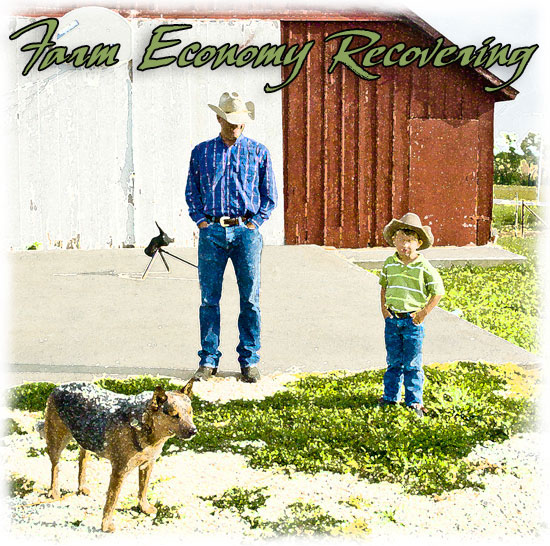MU FAPRI delivers 2011 agricultural economic baseline to U.S. Congress.
Food prices could increase by more than 4% in 2011 as the farm sector recovers from a sharp downturn in the recession, University of Missouri (MU) economists reported to Congress. The MU Food and Agricultural Policy Research Institute (FAPRI) presented its annual report to legislators, Monday, March 7. The annual MU FAPRI baseline shows net farm income may reach a record $99 billion in 2011.
"After two years of very subdued U.S. food price inflation, food prices may increase by 4.2%," said Pat Westhoff, director of MU FAPRI. "Projected food inflation drops to 2%, a level matching overall inflation, after 2012."
Food prices will rise not only from higher prices paid at the farm level for food grains and livestock, but also recent increases in energy costs. Oil prices affect transportation and processing costs up the supply chain as well as agricultural production costs, Westhoff said. During preparation of the baseline, oil prices jumped from $88 per barrel to more than $100.
Higher prices for grain, oilseed and cotton led the farm economic recovery.
"U.S. stocks of corn, soybeans and cotton are very low relative to use in 2010-11," Westhoff said. "Tight supplies have contributed to higher prices. U.S. wheat supplies are not as low, but wheat prices are supported by corn prices and strong export demand."
Use of ethanol, a fuel distilled mostly from corn, has increased rapidly, but may dip if fuel tax credits expire as scheduled at the end of 2011.
Higher feed and other input costs along with lower prices during the recession lowered output of meat and milk. At the same time, domestic and international demand remained strong.
"Reduced production, growing exports and population growth combine to limit supplies of meat and milk for domestic consumers," said Scott Brown, FAPRI livestock economist. "Tight supplies and improving demand initiated price increases in 2010.
"Prices will strengthen for fed steers, feeder calves and hogs," Brown said. Higher prices at the farm will lead to much higher prices for meat and dairy products for consumers. High oil prices add to the costs of moving from farm to feedlots to supermarkets.
Tight supplies could lead to volatility
MU FAPRI warns that tight supplies could lead to volatility in commodity prices.
"For example, an unexpected drop in U.S. corn yields in 2010 led to the rapid increase in world corn prices," Westhoff said. "With stocks limited, a lot depends on the 2011 corn yields. Prices could be much higher — or lower — than our projections."
MU FAPRI projects corn prices at $5.32 per bushel for the 2010-11 crop and $5.03 for the 2011-12 crop. The previous record was $4.20 per bushel for the crop harvested in 2007.
The baseline assumption is that present farm policies remain in place and that normal weather produces trend-line yields. Biofuel tax credits and tariffs are assumed to expire on schedule. This means, for example, that the current credit to ethanol blenders of 45¢ per gallon would be gone by January.
For soybean prices, China remains the driving force. In the past, China's imports grew at the same rate as Brazilian exports, said the MU economists. Now, Chinese imports are growing faster. This boosts U.S. soybean demand and world prices.
MU FAPRI projects soybean average prices at $11.70 per bushel for 2010-11 and $12.53 for 2011-12. Prices are expected to remain strong through the 10-year baseline.
With strong prices, more land will be drawn into crop production. FAPRI reports the area for the 13 major crops will increase almost 8 million acres to top 258 million acres in 2011.
Percentagewise, upland cotton acreage increases the most, up from 10.77 to 12.35 million acres. "As world demand bounced back from the recession, cotton prices surged," Westhoff said. Continued strong demand is expected to keep cotton prices high in 2011-12.
The livestock picture
On the livestock side, beef production will be the lowest since 2005, as livestock compete for land.As production drops, the demand, particularly internationally, continues to grow. "Beef exports are up nearly 1.5 billion pounds (lb.) over five years ago," Brown says. "The profit outlook brightens in 2012, as economic recovery propels beef demand." Boxed beef cutout price projected at $1.57 per lb. in 2010 could hit $1.80 in 2012.
Hog prices are expected to continue to climb in 2011. However, higher feed costs will drop returns back toward breakeven, Brown said. Profits should return to hog farms in 2012 and 2013 as reduced supplies of all meats support prices. The hog price should average near $60 per hundredweight for those years. That's up from $55 in 2010.
Dairy farmers face dropping fluid milk consumption, a long-term trend. However, cheese consumption recovered last year, up a half-pound per person. Per capita consumption is pegged at 35.7 lb. by 2020, up 1.6 lb. from 2011.
Economic recovery and strong international demand will support prices. However, feed costs keep milk returns at historically low levels. Milk cow numbers are expected to drop before recovering by 2020, the end of the baseline.
 The baseline presented to Congress will be used to study the economic impact of proposed policy changes, including the 2012 Farm Bill.
The baseline presented to Congress will be used to study the economic impact of proposed policy changes, including the 2012 Farm Bill."Because of budget constraints, we did not develop a joint 2011 baseline with colleagues at Iowa State University and other institutions," Westhoff said. "MU FAPRI is solely responsible for the projections."
MU FAPRI is a unit of the MU College of Agriculture, Food and Natural Resources.
Editor's Note: The projections were provided prior to the Japan's March 11 earthquake, which is affecting markets.
[Click here to go to the top of the page.]











